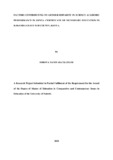| dc.description.abstract | The study investigated the factors that contribute to gender disparities in science in student academic performance in sciences in the Kenya Certificate of Secondary Education (KCSE) examinations. The study was done in Kakamega East Sub-County of Kakamega County, Kenya. Kenya has domesticated international protocols on equal and quality education to
xi
both boys and girls. However, data obtained from the Kenya National Examination Council (KNEC) on KCSE results depicts that boys are performing better than girls in science subjects. Therefore, based on this context, the study examined factors that contribute to gender disparity in sciences. The study further investigated the assumptions underlying gender parity as well as negative influence of gender parity on girls in Kenyan secondary schools. The study identified three research objectives and questions that guided data collection and analysis. The review of the related literature covered three themes, which include pupil’s attitude towards science subjects, socio-economic status, and cultural factors, which addressed the study objectives. In addition, other relevant literature for the study included overview of disparity in sciences and policies on gender parity for quality education. The related literature reviewed led to the specification of knowledge gaps that the study needed to fill. More so, the research work addressed three variables, which include pupils’ attitudes, socio-economic status, and cultural factors. The study design used was descriptive survey. The target population for the study was 12 secondary schools in Kakamega East Sub-county. The entire study population of students sampled was 72. The teachers involved were 36 while the head teachers were 12. The entire target population was 120. The researcher collected data through questionnaires and interview schedule. The collected data were coded thematically. Frequency analysis and findings revealed that socio-economic status of the family, pupil’s attitude, and cultural factors contributed to gender disparity in science performance. The study further concluded that that there is need to urgently address matters that will improve education in all dimensions. The government needs to adopt drastic measures that will ensure equity in education. The study further concluded that the students, the teachers, the school, and the parents have a crucial role to play towards successful achievement in science. It was concluded that boys have a relatively more positive attitude towards the science subjects than the girls. The study concluded that failure among lower-class students with low school success rates is attributed to the lack of friends from the high-class. The study recommended that the Ministry of Education should improve primary school pupils’ science background through inclusion of more introductory Chemistry, Biology, and Physics concepts in the primary science syllabus. Further, the study recommended that the school administration especially in day mixed and girls boarding secondary should organize motivational talks by Chemistry, Physics, and Biology professionals to help change negative attitude of students towards the sciences. In addition, girls should be encouraged to change their attitude towards sciences so that they will be able to take up science-based careers. This will be guided by the vocational and career guidance counselling. | en_US |



